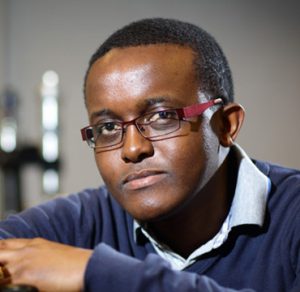Setting up new infrastructures would play an important role in preventing best-trained African researchers from emigrating. The physicist Prosper Ngabonziza states that having a synchrotron light source would be very beneficial for the continent as a whole.
When I started the physics undergraduate program in Rwanda, I wanted to pursue experimental and applied sciences that would involve using research facilities to conduct top-level scientific research for tackling real-life problems. However, there were not always enough equipment and infrastructures available. Oftentimes, we were only getting theoretical knowledge even for experimental and skill-based subjects that needed to be supported by practical works. That was in 2001, and of course there have been positive innovative changes since then in teaching science and skill- based subjects in Rwanda and across Africa.
In this write-up, I would like to reflect, starting from my background, on the role of research infrastructures for meeting both the demand of the scientific community to conduct high-level scientific research and the demand of knowledge transfer for creating innovation and building competitive industries in Africa.

Prosper Ngabonziza, MPI for or Solid State Research (Stuttgart, Germany)
To follow the dream of doing top-level experimental and applied research, I did an experimental research program at the University of Johannesburg in South Africa. This program involved doing experiments at synchrotron radiation source facilities outside Africa, specifically in Europe at Elettra (Trieste, Italy) and SOLEIL (Paris, France). Later, I moved to the University of Twente in The Netherlands, at the MESA+ Institute for Nanotechnology for doing research that required using cleanroom facilities to fabricate electronic devices for potential applications in future quantum technology. Currently, I work at the Max Planck Institute for Solid State Research in Stuttgart, Germany, also doing research that involves using advanced epitaxial deposition systems to grow thin film samples with atomic-layer precision. These samples are later structured, in cleanroom facilities, into electronic chips and iontronic devices that have potential applications for development of alternative energy and environmental friendly technologies.
On the road, while doing experimental sciences, I came to appreciate how research infrastructures are drivers of technological development, and have significantly contributed to societal and scientific advancement around the world. For Africa in particular, there are currently positive changes in regards to research infrastructures; mainly international collaborations that allow African scientists to get access to the most advanced research facilities and institutions around the world. However, for Africa to make technological breakthroughs that enhance innovation and industrial competitiveness, other models should be exploited besides the ‘suitcase scientists’ model, in which African researchers travel abroad to use advanced international research facilities. There should be increased financial investments for building local and regional shared research infrastructures on the continent, of course in collaboration/support with international institutions. But what kinds of infrastructure fit well with the demands of increasingly networked and transdisciplinary researchers who are attempting to address the continent’s grand challenges? And whose responsibility is it to build such multi-disciplinary research facilities?
What kinds of research infrastructures?
Research infrastructures are facilities used by the scientific community to carry out exploratory research in different fields using diversified scientific instruments to address well-defined questions. Answering such questions often leads, both in the short- and long-term, ultimately to a wide range of practical applications and defines pathways for addressing global challenges, such as tackling endemic diseases, food security and scarcity of clean water.
To address Africa’s huge challenges in the long-term requires research activities in nearly all scientific disciplines and the utilization of scientific infrastructures that are both multi- and inter-disciplinary. Such infrastructures should bring together research activities in medical sciences, environmental sciences, energy sciences, materials sciences, and cultural heritage sciences amongst others. One of the reasons Africa needs such infrastructures is that scientists could, for example, develop cures for diseases of particular relevance to Africa that may not be receiving sufficient research attention from outside. Africa cannot continue waiting for those outside the continent to take the lead in developing treatments for diseases like Ebola and malaria.
The evident choice of such a large scale multi- and inter-disciplinary research infrastructure is a synchrotron light source (SLS). A SLS is a mega-scale research and industrial infrastructure that delivers light that can be billions of times brighter than our sun [1]. This extremely bright light is useful for imaging viruses, bacteria, cells and nanostructures, to name but a few. Knowledge from such images can be extremely useful in addressing health/medical/biomedical problems, environmental problems, and in the development of novel materials and devices that could lead to diversified technological applications for Africa and even the world at large. An SLS also could generate a combined science and industrial park that springs up around it and become a clustered science-megalopolis of globally competitive research activities, training and innovations. However, for now, Africa is the only habitable continent without an SLS [2,3]. African researchers and scientists have to travel abroad to perform experiments at facilities in Europe, South and North America, Asia and Australia [2].
The need for a synchrotron light source in Africa
Having such an advanced light source in Africa would be very beneficial to the continent as a whole. Currently Africa is losing many of its talented and energetic young scientists to the African science Diaspora. The research work that we are doing abroad is not possible with the current research and scientific facilities in Africa. An SLS would play an important role in retaining talented scientists and preventing the best-trained researchers and multi-disciplinary innovators from emigrating. So siting such a mega-scale infrastructure somewhere in Africa would make that region a unifying point and a leader in bringing many African and international scientists together. In addition to the above scientific benefits, such a large-scale infrastructure would also play a pivotal role in seeding local competitive industries on the continent.
In particular, an SLS in Africa would enhance the advancement of basic and applied scientific research and capacity-building on the continent. Advanced techniques employed at an SLS would be applied for research in many fields that are relevant for Africa. For example, in agriculture for the analysis of soil and environmental pollutants; in health for tackling and development of new drugs for malaria, HIV, tuberculosis and Ebola, which are amongst the top challenges facing Africa today.
Furthermore, SLSs are complex machines requiring an enormous range of scientific, mathematical, engineering, technological and industrial skills. Thus, it is envisaged that the African SLS would open employment opportunities for Africans, international engineers, and people having a diversity of qualifications. Other socio-economic benefits for an African SLS include the growth of spin-off companies for technological development and innovation and the generation of employment opportunities for qualified African youth. The African SLS would also give African countries another opportunity to work together in taking control of their destinies and becoming major players in the international community.
On the other hand, there have been questions as to whether Africa is actually prepared for such a sophisticated large- scale scientific infrastructure., The answer is YES since there is increased trained capacity within both Africa and the African Diaspora with extensive SLS experience [3]. The cost of an SLS is not small (~ 0.5 to 1 billion Euros to construct, plus operation and maintenance costs, and also upgrade costs every decade thereafter); but all these costs are within the reach of African countries; in particular easily manageable by all African nations as a Pan-African large-scale facility.
But whose responsibility is it to advocate and build such a mega-science techno-industrial research facility?
There are different contributors to this venture who should work together in a coherent manner towards a common goal of making the African SLS a reality. Stakeholders can be mainly divided into two categories:
1. African scientists (together with international colleagues):
African scientists with extensive SLS experience, in collaboration with their international colleagues, have already come together to advocate for the African SLS project. Our activities are mostly coordinated within the African Light Source (AfLS) Foundation, which is a legal entity with a constitution and registered as a Trust in the Masters Office of the High Court in South Africa [4]. The AfLS project is coordinated by a fully mandated Steering Committee composed of a combination of established African and International scientists whose vision and goal is to have an SLS in Africa in the not-too-distant future [4]. Details on the history and progress of the AfLS are documented in refs [2, 3].
This AfLS Foundation has already produced a roadmap of the African SLS, which involves training of African young scientists in the advanced research techniques available at SLS. These trainings are already happening in collaboration with different SLSs around the world, and they are mostly supported by Lightsources for Africa, the Americas, Asia and Middle East Project (LAAAMP) [5].
The AfLS Foundation has also organized a number of international conferences and workshops to promote the AfLS project. The first AfLS conference and workshop was held at the European Synchrotron Radiation Facility (ESRF) in Grenoble, France in 2015. The second AfLS conference was held in parallel with the Pan- African Conference on Crystallography in Accra, Ghana this year [3]. The third AfLS (AfLS3) conference will convene in Kigali, Rwanda during November 2020 [6]. One of the anticipated outcomes of the AfLS3 is the production of a pre-Conceptual Design Report (pre-CDR) that will pave the way for a final African SLS CDR. This CDR will contain detailed information about scientific, business, and technical issues for the African SLS; and discussions that address questions of what, why, how, and when.
All the above developments towards an African SLS from a scientific point of view demonstrate that there is already good momentum for making an African SLS a reality. But as this sophisticated large-scale scientific infrastructure requires not only scientific and engineering knowledge but also huge investments, it is also necessary to get enough support from significant Pan-African organizations and African governments.
2. Pan-African organizations and African governments:
One of the prominent Pan-African organizations that is also working towards the African SLS is the African Academy of Sciences (AAS). Both the AfLS Foundation and the AAS have been involved in conversations with the African Union (AU). The AfLS project is slowly becoming ever more firmly established on the agenda of the AU [3].
There are also different governments that have been supportive of the African SLS initiative. South Africa, which for example has already a critical mass of SLS users, is an associate member of the ESRF since 2013. This agreement provides training opportunities for South African and other African researchers;, thereby enhancing knowledge in synchrotron science in the region. Another example is the new X-TechLab in Benin that was recently inaugurated with the strong support of the Benin government and LAAAMP. This research facility is contributing as a feeder infrastructure of the African SLS by training local and other African researchers in X-ray sciences. The Ghanaian Government has also chosen to champion the African SLS wherever it may ultimately be built. Hence, there has been excellent progress from both the scientific and political support points of view. Hopefully, in the near future the African SLS will be built somewhere in Africa.

